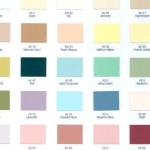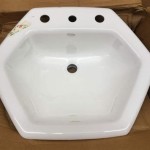Latest Trends in Bathroom Sink Design
The bathroom sink, once a purely functional fixture, has evolved into a pivotal element of bathroom design. Current trends showcase a shift towards personalization, incorporating diverse materials, innovative shapes, and advanced functionality. This article explores some of the latest developments in bathroom sink design, focusing on key areas that are shaping the modern bathroom aesthetic.
Material Innovations
Traditional bathroom sinks were predominantly crafted from vitreous china or porcelain. While these materials remain popular due to their durability and ease of cleaning, contemporary designs are increasingly exploring a wider range of materials. These alternative materials offer different aesthetic qualities and performance characteristics.
One notable material is concrete. Concrete sinks offer a raw, industrial aesthetic that is increasingly popular in minimalist and contemporary bathrooms. Concrete can be molded into various shapes and can be sealed to create a water-resistant surface. The unique variations in texture and color inherent in concrete add character to each sink, ensuring that no two are exactly alike. The density of concrete also contributes to sound dampening, reducing the noise of running water. However, concrete sinks can be more porous than traditional materials and require regular sealing to prevent staining and water damage.
Another emerging material is stone. Natural stone, such as marble, granite, and travertine, offers a luxurious and timeless appeal. Stone sinks are often carved from a single block of material, showcasing the natural beauty of the stone's veining and patterns. These sinks require careful maintenance to prevent staining and etching from acidic substances. Engineered stone, such as quartz and solid surface materials, offers a more durable and low-maintenance alternative to natural stone while still providing a similar aesthetic. Engineered stone is non-porous, resistant to scratches and stains, and can be molded into seamless designs.
Glass is also gaining popularity as a sink material. Glass sinks can be transparent, translucent, or opaque, and can be tinted in a variety of colors. Tempered glass is used to ensure durability and resistance to shattering. Glass sinks offer a modern and elegant look and are relatively easy to clean. However, they are susceptible to water spots and fingerprints and may require more frequent cleaning to maintain their pristine appearance.
Metal sinks, particularly those made from stainless steel, copper, or brass, offer a durable and stylish option. Stainless steel sinks are known for their durability, resistance to corrosion, and ease of cleaning. Copper sinks offer a warm, rustic aesthetic and possess natural antimicrobial properties. Brass sinks provide a luxurious and timeless look and are also resistant to corrosion. Metal sinks can be prone to scratches and water spots, and may require special cleaning products to maintain their finish.
Evolving Sink Styles and Shapes
Beyond materials, the shapes and styles of bathroom sinks are also undergoing significant transformations. The traditional pedestal sink is giving way to more streamlined and space-saving designs.
Vessel sinks, which sit on top of the countertop, remain a popular choice for adding visual interest to a bathroom. These sinks come in a wide range of shapes, sizes, and materials, allowing for a high degree of customization. Vessel sinks can be round, square, rectangular, or even asymmetrical, and can be made from materials such as glass, stone, metal, or ceramic. Installation requires careful consideration of the height of the countertop and the faucet to ensure ergonomic comfort.
Undermount sinks, which are installed beneath the countertop, offer a seamless and minimalist look. These sinks are easy to clean as there is no rim to collect dirt or grime. Undermount sinks are compatible with a variety of countertop materials, including stone, quartz, and solid surface. The choice of sink shape is crucial for seamlessly integrating into the overall design of the bathroom.
Wall-mounted sinks are ideal for small bathrooms or powder rooms where space is limited. These sinks are mounted directly to the wall, freeing up floor space and creating a sense of openness. Wall-mounted sinks can be paired with a minimalist faucet and drain for a clean and modern look. Installation requires careful planning to ensure adequate support for the sink and plumbing connections.
Integrated sinks, where the sink and countertop are made from a single piece of material, offer a seamless and hygienic solution. These sinks are typically made from solid surface materials or cast polymers and are available in a variety of shapes and sizes. Integrated sinks are easy to clean and maintain and provide a clean, modern aesthetic.
Corner sinks are specifically designed for small bathrooms with limited space. These sinks fit snugly into a corner, maximizing the available space and providing a functional washing area. Corner sinks are available in a variety of styles and materials and can be wall-mounted or pedestal-mounted.
Advanced Functionality and Technology
In addition to aesthetic considerations, the functionality of bathroom sinks is also evolving with the integration of advanced technologies. These technologies enhance user experience and promote water conservation.
Touchless faucets, which use sensors to detect hand movement, are becoming increasingly popular in both residential and commercial bathrooms. Touchless faucets offer a hygienic solution, reducing the spread of germs and bacteria. They also help to conserve water by automatically shutting off when hands are removed. These faucets require a power source, either battery or electrical, and may require professional installation.
Water-saving faucets are designed to reduce water consumption without sacrificing water pressure. These faucets often incorporate aerators that mix air with water, creating a strong and consistent flow while using less water. Some faucets also feature flow restrictors that limit the amount of water that can flow through the faucet. Water-saving faucets can help to reduce water bills and conserve natural resources.
Integrated lighting is another emerging trend in bathroom sink design. LED lights can be incorporated into the sink itself or into the surrounding countertop or mirror. Integrated lighting provides ambient illumination, enhancing the overall ambiance of the bathroom. LED lights are energy-efficient and long-lasting, making them a sustainable choice.
Smart sinks that incorporate sensors and connectivity features are also beginning to emerge. These sinks can monitor water usage, detect leaks, and even adjust water temperature automatically. Smart sinks can be controlled remotely via a smartphone app, providing users with greater control over their water consumption and energy usage. These sinks represent a significant advancement in bathroom technology, though widespread adoption is still in its early stages.
Heated sinks, while less common, offer a luxurious and comfortable experience, particularly in colder climates. These sinks use a heating element to warm the surface of the sink, providing a warm and soothing sensation when washing hands. Heated sinks require a power source and may require professional installation.
The incorporation of nanotechnology into sink materials is also being explored. Nanocoatings can create surfaces that are highly resistant to water, dirt, and bacteria, making them easier to clean and maintain. These coatings can also enhance the durability and longevity of the sink.
These latest trends in bathroom sink design reflect a broader movement towards personalization, innovation, and sustainability. By exploring different materials, shapes, and technologies, homeowners and designers can create bathrooms that are both aesthetically pleasing and highly functional, with a focus on conserving water and enhancing the user experience.

Modern Bathroom Vanity Design Regalo Kitchens

The Right Vessel Sink Can Create Perfect Contemporary Bathroom Beautiful Homes

51 Bathroom Sinks That Are Overflowing With Stylistic Charm

51 Bathroom Sinks That Are Overflowing With Stylistic Charm

17 Modern Designs Of Bathroom Sinks Sink Design Contemporary

Bathroom Sink Styles
:strip_icc()/101563300-99199e163c1746468060e43c7fcde145.jpg?strip=all)
48 Modern Bathroom Ideas For A Spa Like Escape

Minimalist Wash Basin Designs For Bathroom

European Standard Whole Modern Hotel Design Led Bathroom Mirror Slate Top Ceramic Wash Basin Sink Floating Vanity With China Made In Com

Turn Your Small Bathroom Big On Style With These 15 Modern Sink Designs Design Contemporary Decor
Related Posts







